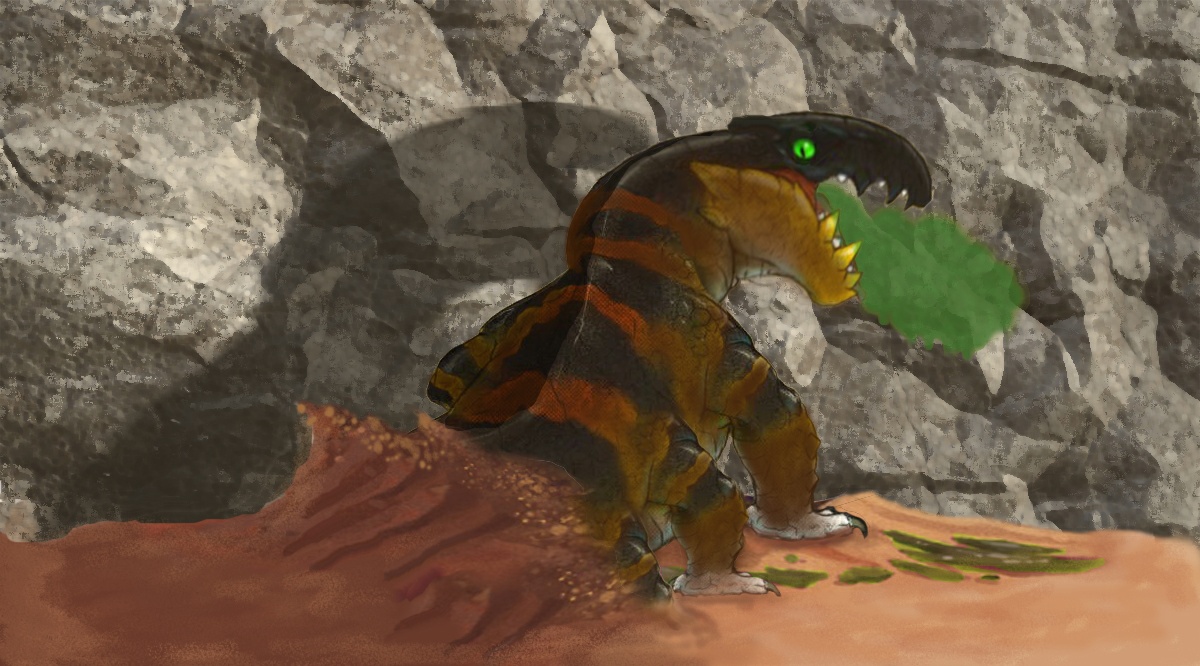Banded Sand Basilisk
The banded sand basilisk is a cousin to the more common basilisk, but instead of a petrifying gaze, its attack is linked to the spray of venom it can spit in a cloud of greyish-green droplets. The venom cloud swiftly converts petrified victims to sandstone. Its ability to disappear beneath the sand, swim away, then reappear to strike without warning, has been the downfall of many would-be monster hunters.
A sand basilisk is a ruthless and determined predator but is fortunately rarely encountered. It prefers to lie just under the sand basking and waiting for prey on reasonably well travelled routes. If it determines that the prey is an easy kill it will stealthily sand glide up to the target and attempt to kill the prey with its bite alone, however if the prey is large or particularly dangerous, the sand basilisk will not hesitate to use its petrifying venom.
When a sand basilisk is wounded or in danger, it will spend a few seconds madly thrashing its limbs and tails against the surface of the sand as if it is trying to swim. The resultant cloud of sand lingers in the air for several seconds, long enough to cover its escape as it dives beneath the surface and swims away or repositions itself for another attack.
Experienced desert travellers know that a slain basilisk can be butchered and if successful, the stomach juices can be extracted and applied to a petrified victim to restore them back to flesh. A typical sand basilisk's stomach will contain only enough juice to apply to one or two victims.
Basic Information
Anatomy
Sand basilisks are distinctive for their eight short legs and powerfully muscled tail. The tail is flattened vertically, allowing it to push against the sand as it swims in a snake-like motion beneath the surface. The short snout has strong muscles, although not as much as its basilisk cousin.
Ecology and Habitats
A sand basilisk prefers desert regions with loose sand it can burrow into, and rocks it can camouflage itself and its victims against. Rocky crevasses and ravines on the edges of the desert are particularly favoured. In areas where prey is constant and plentiful, a banded sand basilisk can often become aggressive and territorial.
Dietary Needs and Habits
A successful hunter will often break up excess petrified prey to dine on at a later date, scattering the chunks of sandstone in the sand where it lairs. It can feed upon almost any kind of meat, and its venom can affect even the largest of creatures. One sand basilisk successfully petrified a purple worm which was attacking it. As the basilisk feeds on the sandstone chunks, the juices in its stomach convert the stone back to flesh for digestion.
Additional Information
Social Structure
Sand basilisks are solitary hunters, only seeking out others of their kind during mating season, which typically only happens every five years. The basilisks are drawn together by pheromones, then the female drives away the male before laying eggs in a burrow dug into the sand. Up to twenty eggs are contained in each clutch, but the first to hatch will often devour some or all of their siblings.
Geographic Origin and Distribution
The banded sand basilisk does not roam nearly as widely as its more commonly-encountered cousin. As it is adapted to warmer temperatures and hunting in sand, it is usually only found in deserts.
Average Intelligence
A sand basilisk can be successfully trained to serve as a companion and guard animal, as it is slightly more intelligent than a dog. It will become aggressive when hungry, however, even against its trainer.
Perception and Sensory Capabilities
The sand basilisk is extremely efficient at detecting approaching prey via vibrations in the ground as it lies in wait beneath the sand. It also possesses a form of darkvision allowing it to see clearly at night.
Body Tint, Colouring and Marking
The striped dark grey and rusty yellow-orange hide forms an effective disguise for the sand basilisk. The colouration breaks up its outline and makes it hard to see at any distance, especially at night or against rocks.
Geographic Distribution



Comments